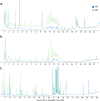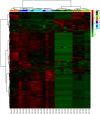Dissecting fine-flavor cocoa bean fermentation through metabolomics analysis to break down the current metabolic paradigm
- PMID: 34754023
- PMCID: PMC8578666
- DOI: 10.1038/s41598-021-01427-8
Dissecting fine-flavor cocoa bean fermentation through metabolomics analysis to break down the current metabolic paradigm
Abstract
Cocoa fermentation plays a crucial role in producing flavor and bioactive compounds of high demand for food and nutraceutical industries. Such fermentations are frequently described as a succession of three main groups of microorganisms (i.e., yeast, lactic acid, and acetic acid bacteria), each producing a relevant metabolite (i.e., ethanol, lactic acid, and acetic acid). Nevertheless, this view of fermentation overlooks two critical observations: the role of minor groups of microorganisms to produce valuable compounds and the influence of environmental factors (other than oxygen availability) on their biosynthesis. Dissecting the metabolome during spontaneous cocoa fermentation is a current challenge for the rational design of controlled fermentations. This study evaluates variations in the metabolic fingerprint during spontaneous fermentation of fine flavor cocoa through a multiplatform metabolomics approach. Our data suggested the presence of two phases of differential metabolic activity that correlate with the observed variations on temperature over fermentations: an exothermic and an isothermic phase. We observed a continuous increase in temperature from day 0 to day 4 of fermentation and a significant variation in flavonoids and peptides between phases. While the second phase, from day four on, was characterized for lower metabolic activity, concomitant with small upward and downward fluctuations in temperature. Our work is the first to reveal two phases of metabolic activity concomitant with two temperature phases during spontaneous cocoa fermentation. Here, we proposed a new paradigm of cocoa fermentation that considers the changes in the global metabolic activity over fermentation, thus changing the current paradigm based only on three main groups of microorganism and their primary metabolic products.
© 2021. The Author(s).
Conflict of interest statement
The authors declare no competing interests.
Figures









Similar articles
-
Species diversity, community dynamics, and metabolite kinetics of the microbiota associated with traditional ecuadorian spontaneous cocoa bean fermentations.Appl Environ Microbiol. 2011 Nov;77(21):7698-714. doi: 10.1128/AEM.05523-11. Epub 2011 Sep 16. Appl Environ Microbiol. 2011. PMID: 21926224 Free PMC article.
-
The effect of lactic acid bacteria on cocoa bean fermentation.Int J Food Microbiol. 2015 Jul 16;205:54-67. doi: 10.1016/j.ijfoodmicro.2015.03.031. Epub 2015 Apr 3. Int J Food Microbiol. 2015. PMID: 25889523
-
Dynamics and species diversity of communities of lactic acid bacteria and acetic acid bacteria during spontaneous cocoa bean fermentation in vessels.Food Microbiol. 2011 May;28(3):457-64. doi: 10.1016/j.fm.2010.10.010. Epub 2010 Oct 27. Food Microbiol. 2011. PMID: 21356451
-
The cocoa bean fermentation process: from ecosystem analysis to starter culture development.J Appl Microbiol. 2016 Jul;121(1):5-17. doi: 10.1111/jam.13045. Epub 2016 Feb 13. J Appl Microbiol. 2016. PMID: 26743883 Review.
-
Functional role of yeasts, lactic acid bacteria and acetic acid bacteria in cocoa fermentation processes.FEMS Microbiol Rev. 2020 Jul 1;44(4):432-453. doi: 10.1093/femsre/fuaa014. FEMS Microbiol Rev. 2020. PMID: 32420601 Review.
Cited by
-
Reduction in the Cocoa Spontaneous and Starter Culture Fermentation Time Based on the Antioxidant Profile Characterization.Foods. 2023 Sep 1;12(17):3291. doi: 10.3390/foods12173291. Foods. 2023. PMID: 37685224 Free PMC article.
-
Experimental Prototype of Electromagnetic Emissions for Biotechnological Research: Monitoring Cocoa Bean Fermentation Parameters.Foods. 2023 Jun 29;12(13):2539. doi: 10.3390/foods12132539. Foods. 2023. PMID: 37444278 Free PMC article.
-
Bacterial and Fungal Communities Are Specifically Modulated by the Cocoa Bean Fermentation Method.Foods. 2023 May 17;12(10):2024. doi: 10.3390/foods12102024. Foods. 2023. PMID: 37238842 Free PMC article.
-
Integration of network-based approaches for assessing variations in metabolic profiles of alkalized and non-alkalized commercial cocoa powders.Food Chem X. 2024 Jul 15;23:101651. doi: 10.1016/j.fochx.2024.101651. eCollection 2024 Oct 30. Food Chem X. 2024. PMID: 39148527 Free PMC article.
-
Shades of Fine Dark Chocolate Colors: Polyphenol Metabolomics and Molecular Networking to Enlighten the Brown from the Black.Metabolites. 2023 May 17;13(5):667. doi: 10.3390/metabo13050667. Metabolites. 2023. PMID: 37233708 Free PMC article.
References
-
- Ordoñez-Araque RH, Landines-Vera EF, Urresto-Villegas JC, Caicedo-Jaramillo CF. Microorganisms during cocoa fermentation: Systematic review. Foods Raw Mater. 2020;8:155–162. doi: 10.21603/2308-4057-2020-1-155-162. - DOI
-
- Tran PD, et al. Assessing cocoa aroma quality by multiple analytical approaches. Food Res. Int. 2015;77:657–669. doi: 10.1016/j.foodres.2015.09.019. - DOI
LinkOut - more resources
Full Text Sources

